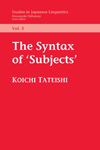

|
|
|
|

The Syntax of ‘Subjects’Linguists who work on the Japanese language have disagreed about the notion of subject with respect to Japanese; many linguists argue that there is no formal syntactic position for the subject in Japanese. Tateishi does deeper research on the surface syntax of the subject, and looks in particular at the syntax of the subject and phenomena which have been treated as S-adjunctions. These two have been identified with each other on many occasions in the history of Japanese linguistics and are of interest with respect to the debate over configurationality in the language, which has been revived in different forms following the emergence of the VP-Internal Subject Hypothesis, the merits of which Tateishi discusses at length. Tateishi's main claim is that despite all the non-configurational characteristics found in the language, Japanese is in a sense more configurational than the so-called configurational languages. Japanese allows more types of hierarchies to be involved in the subject-predicate relation than English allows, as Japanese does not have the same kind of restrictions on the phrase structure as the configurational languages have. is a professor of linguistics at the Kyoto University of Foreign Studies. Contents
6/1/94 ISBN (Paperback): 1881526453 (9781881526452)
Subject: Linguistics; Grammar--Noun Phrase; Grammar--Syntax |
Distributed by the
University of Chicago Press |
|
pubs @ csli.stanford.edu
|
CSLI Publications
Stanford University Cordura Hall 210 Panama Street Stanford, CA 94305-4101 (650) 723-1839 |